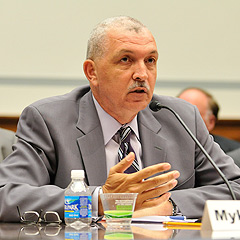July 28, 2008
APWU Testimony Assails Latest ‘USPS Network Plan’

The Postal Service’s strategy for “network realignment” is based on a faulty premise, APWU Legislative Director Myke Reid told lawmakers July 24. The stated objective of the USPS Network Plan is to promote efficiency by eliminating redundancy, he said. “But the fallacy of the plan is that it artificially limits the definition of the postal network.
“By intentional design, the plan considers only the 400-plus USPS mail processing facilities to be ‘the network,’ while in reality, the network consists of both public and private facilities that prepare mail for delivery by USPS employees.” Reid testified before the House Subcommittee on Federal Workforce, Post Office, and the District of Columbia during a hearing on the latest reincarnation of the Postal Service network realignment plan.
Reid pointed out that the Postal Service is playing against a stacked deck. “Facilities owned and operated by Pitney Bowes and RR Donnelley,” he said, “perform many of the same functions as those performed at USPS facilities. The most significant distinction between the two systems is that the postal processing system must accept single pieces of mail, while the private system processes only commercial mailings.
“Two identical letters, one deposited by an individual citizen and another by a commercial mailer, will receive the same depth of processing — one in the postal network and the other in the private structure,” Reid said, calling them inseparable. “Any effort to redesign the location of processing activities must include a review of the entire mail processing network.”
USPS Financed the System
The Postal Service has financed the creation of the private network, he testified. “The research and development costs of the technology used to modernize processing have been borne almost entirely by the Postal Service — in amounts totaling billions of dollars: But once the technology has been proven to be effective, it is adopted by the private system. And the private, for-profit network continues to draw the revenue to operate its plants from the postal rate structure.”
As the union has in the past, Reid blamed workshare discounts for depriving the Postal Service of needed funds: “Each dollar in workshare discounts that is granted to private processors represents a direct loss in postal revenue,” he said.
“An increase in the share of volume in the private system has an adverse effect on the postal network,” Reid told House members. “The cost of processing mail in the postal system increases as mail is diverted to the private system: Equipment is not used to capacity, and, as a result, the USPS per-piece cost increases.”
The logistics of the mail-processing system demand that it be coordinated into a national network — which only the USPS, a public service, is willing and able to provide, Reid told lawmakers.
Obscuring Changes
“The Postal Service’s plans for network realignment have passed through many stages,” Reid noted. “Each of the previous proposals lacked transparency, and the current plan continues that unfortunate tradition.”
One glaring example is that the USPS fails to consider later delivery times or earlier pick-up times degradations in service, he said. But to businesses or individuals who depend on timely mail delivery, these changes can be of substantial consequence.
As further evidence of the lack of transparency, Reid said, “I ask members of the Committee a simple question: After reading the plan, do you have a clear idea of which facilities would be consolidated and what criteria would be used to make the decisions?”
In response to recent attempts to realign the postal network, the union took action on both the national and local levels, Reid told lawmakers. “Whenever we alerted citizens that their postal facilities were threatened with closure or their postal services would be degraded, they and their elected representatives have responded vigorously.”
Creating Redundancy
“By encouraging the growth of the private-sector network, the Postal Service is creating redundancy rather than eliminating it,” he observed.
“Pretending that the postal network consists solely of USPS facilities does not make it true. The fact is that both the postal and private, for-profit networks comprise the postal processing system. Any review of the network must consider the combined system…
“The question that now must be asked is whether universal mail service is intended to provide a service to the American people, or a vehicle for corporate profit.”
Also testifying were representatives of the USPS, the U.S. Government Accountability Office, the Office of Inspector General of the USPS, the Postal Regulatory Commission, major mailers organizations, and the National Postal Mail Handlers Union.



